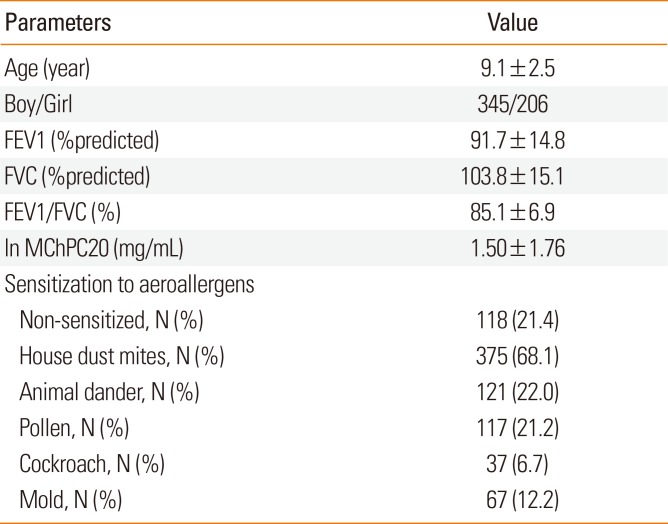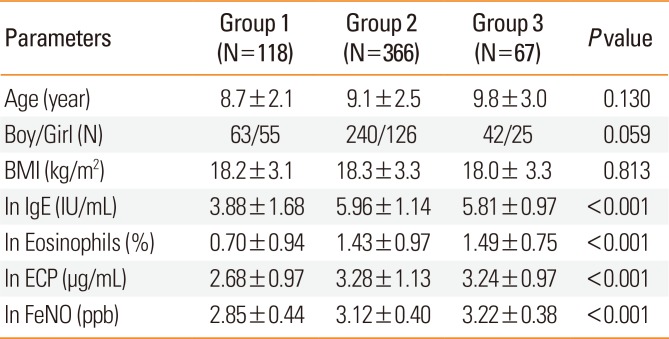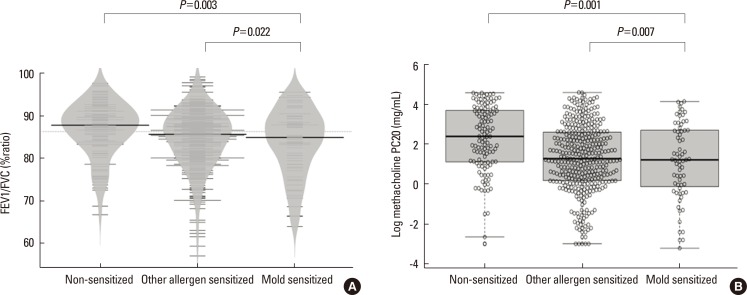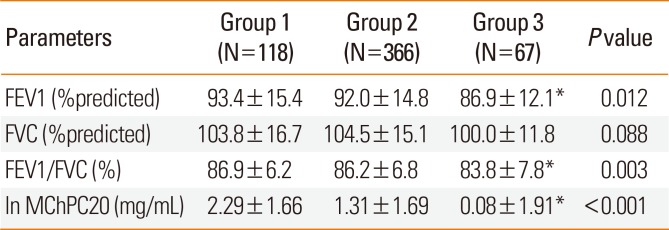1. Gent JF, Kezik JM, Hill ME, Tsai E, Li DW, Leaderer BP. Household mold and dust allergens: exposure, sensitization and childhood asthma morbidity. Environ Res. 2012; 118:86–93. PMID:
22863552.

2. Ezeamuzie CI, Al-Ali S, Khan M, Hijazi Z, Dowaisan A, Thomson MS, et al. IgE-mediated sensitization to mould allergens among patients with allergic respiratory diseases in a desert environment. Int Arch Allergy Immunol. 2000; 121:300–307. PMID:
10828720.

3. Moreno A, Pineda F, Alcover J, Rodríguez D, Palacios R, Martínez-Naves E. Orthologous allergens and diagnostic utility of major allergen Alt a 1. Allergy Asthma Immunol Res. 2016; 8:428–437. PMID:
27334781.

4. Menzies D, Holmes L, McCumesky G, Prys-Picard C, Niven R.
Aspergillus sensitization is associated with airflow limitation and bronchiectasis in severe asthma. Allergy. 2011; 66:679–685. PMID:
21261660.
5. Vicencio AG, Santiago MT, Tsirilakis K, Stone A, Worgall S, Foley EA, et al. Fungal sensitization in childhood persistent asthma is associated with disease severity. Pediatr Pulmonol. 2014; 49:8–14. PMID:
23401301.

6. Niedoszytko M, Chełmińska M, Jassem E, Czestochowska E. Association between sensitization to
Aureobasidium pullulans (
Pullularia sp) and severity of asthma. Ann Allergy Asthma Immunol. 2007; 98:153–156. PMID:
17304882.
7. Plaza V, Serrano J, Picado C, Cosano J, Ancochea J, de Diego A, et al. Clinical characteristics of the fatal and near-fatal asthma in
Alternaria alternata sensitized patients. Med Clin (Barc). 2003; 121:721–724. PMID:
14678692.
8. Black PN, Udy AA, Brodie SM. Sensitivity to fungal allergens is a risk factor for life-threatening asthma. Allergy. 2000; 55:501–504. PMID:
10843433.

9. Pongracic JA, O'Connor GT, Muilenberg ML, Vaughn B, Gold DR, Kattan M, et al. Differential effects of outdoor versus indoor fungal spores on asthma morbidity in inner-city children. J Allergy Clin Immunol. 2010; 125:593–599. PMID:
20132971.

10. O'Hollaren MT, Yunginger JW, Offord KP, Somers MJ, O'Connell EJ, Ballard DJ, et al. Exposure to an aeroallergen as a possible precipitating factor in respiratory arrest in young patients with asthma. N Engl J Med. 1991; 324:359–363. PMID:
1987459.
11. Chinn S, Jarvis D, Luczynska C, Burney P. Individual allergens as risk factors for bronchial responsiveness in young adults. Thorax. 1998; 53:662–667. PMID:
9828852.

12. Fairs A, Agbetile J, Hargadon B, Bourne M, Monteiro WR, Brightling CE, et al. IgE sensitization to
Aspergillus fumigatus is associated with reduced lung function in asthma. Am J Respir Crit Care Med. 2010; 182:1362–1368. PMID:
20639442.
13. Ma Y, Tian G, Tang F, Yu B, Chen Y, Cui Y, et al. The link between mold sensitivity and asthma severity in a cohort of northern Chinese patients. J Thorac Dis. 2015; 7:585–590. PMID:
25973223.
14. Jo EJ, Kim MY, Lee SE, Lee SY, Kim MH, Song WJ, et al. Eosinophilic airway inflammation and airway hyperresponsiveness according to aeroallergen sensitization pattern in patients with lower airway symptoms. Allergy Asthma Immunol Res. 2014; 6:39–46. PMID:
24404392.

15. Schwartz J, Weiss ST. Relationship of skin test reactivity to decrements in pulmonary function in children with asthma or frequent wheezing. Am J Respir Crit Care Med. 1995; 152:2176–2180. PMID:
8520794.

16. Hanifin JM, Rajka G. Diagnostic features of atopic dermatitis. Acta Derm Venereol Suppl (Stockh). 1980; 92:44–47.
17. American Thoracic Society. Standardization of spirometry, 1994 update. Am J Respir Crit Care Med. 1995; 152:1107–1136. PMID:
7663792.
18. Chai H, Farr RS, Froehlich LA, Mathison DA, McLean JA, Rosenthal RR, et al. Standardization of bronchial inhalation challenge procedures. J Allergy Clin Immunol. 1975; 56:323–327. PMID:
1176724.

19. Twaroch TE, Curin M, Valenta R, Swoboda I. Mold allergens in respiratory allergy: from structure to therapy. Allergy Asthma Immunol Res. 2015; 7:205–220. PMID:
25840710.

20. Mari A, Schneider P, Wally V, Breitenbach M, Simon-Nobbe B. Sensitization to fungi: epidemiology, comparative skin tests, and IgE reactivity of fungal extracts. Clin Exp Allergy. 2003; 33:1429–1438. PMID:
14519151.

21. Bartra J, Belmonte J, Torres-Rodriguez JM, Cistero-Bahima A. Sensitization to
Alternaria in patients with respiratory allergy. Front Biosci (Landmark Ed). 2009; 14:3372–3379. PMID:
19273281.
22. Kim DH, Park YS, Jang HJ, Kim JH, Lim DH. Prevalence and allergen of allergic rhinitis in Korean children. Am J Rhinol Allergy. 2016; 30:72–78. PMID:
27216339.

23. Park SH, Lim DH, Son BK, Kim JH, Song YE, Oh IB, et al. Sensitization rates of airborne pollen and mold in children. Korean J Pediatr. 2012; 55:322–329. PMID:
23049589.

24. Reponen T, Lockey J, Bernstein DI, Vesper SJ, Levin L, Khurana Hershey GK, et al. Infant origins of childhood asthma associated with specific molds. J Allergy Clin Immunol. 2012; 130:639–644.e5. PMID:
22789397.

25. Kennedy K, Grimes C. Indoor water and dampness and the health effects on children: a review. Curr Allergy Asthma Rep. 2013; 13:672–680. PMID:
24249387.

26. Zureik M, Neukirch C, Leynaert B, Liard R, Bousquet J, Neukirch F. Sensitisation to airborne moulds and severity of asthma: cross sectional study from European Community respiratory health survey. BMJ. 2002; 325:411–414. PMID:
12193354.

27. Karvala K, Toskala E, Luukkonen R, Lappalainen S, Uitti J, Nordman H. New-onset adult asthma in relation to damp and moldy workplaces. Int Arch Occup Environ Health. 2010; 83:855–865. PMID:
20127354.

28. Halonen M, Stern DA, Wright AL, Taussig LM, Martinez FD.
Alternaria as a major allergen for asthma in children raised in a desert environment. Am J Respir Crit Care Med. 1997; 155:1356–1361. PMID:
9105079.
29. Stern DA, Morgan WJ, Halonen M, Wright AL, Martinez FD. Wheezing and bronchial hyper-responsiveness in early childhood as predictors of newly diagnosed asthma in early adulthood: a longitudinal birth-cohort study. Lancet. 2008; 372:1058–1064. PMID:
18805334.

30. Yoo Y. Does specific fungal allergen really matter? Allergy Asthma Immunol Res. 2016; 8:389–390. PMID:
27334775.

31. Denning DW, O'Driscoll BR, Hogaboam CM, Bowyer P, Niven RM. The link between fungi and severe asthma: a summary of the evidence. Eur Respir J. 2006; 27:615–626. PMID:
16507864.

32. Li J, Huang Y, Lin X, Zhao D, Tan G, Wu J, et al. Influence of degree of specific allergic sensitivity on severity of rhinitis and asthma in Chinese allergic patients. Respir Res. 2011; 12:95. PMID:
21831329.

33. Wiszniewska M, Tymoszuk D, Nowakowska-świrta E, Pałczyński C, Walusiak-Skorupa J. Mould sensitisation among bakers and farmers with work-related respiratory symptoms. Ind Health. 2013; 51:275–284. PMID:
23385429.

34. Lemanske RF Jr, Busse WW. 6. asthma. J Allergy Clin Immunol. 2003; 111:S502–S519. PMID:
12592297.











 PDF
PDF ePub
ePub Citation
Citation Print
Print



 XML Download
XML Download